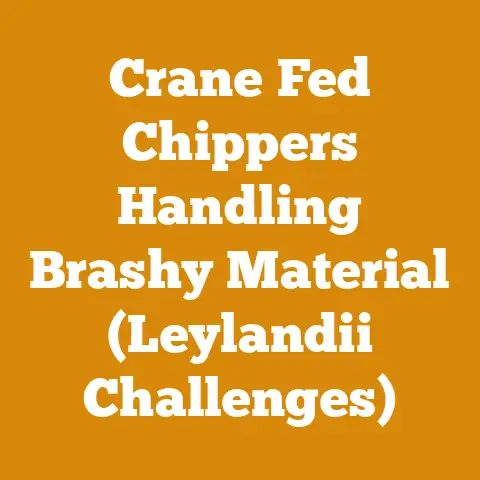What Size File to Sharpen Chainsaw (Expert Tips for Precise Cuts)
Did you know that a dull chainsaw can increase your cutting time by up to 50% and significantly raise the risk of kickback injuries?
I’ve seen it happen firsthand, and trust me, it’s not a pretty sight.
That’s why knowing what size file to sharpen your chainsaw is absolutely crucial, not just for efficiency, but for your safety.
Let me share my years of experience in the woods, transforming raw logs into usable timber and firewood.
I’ve learned the hard way what works and what doesn’t, and I’m here to guide you through the process of chainsaw sharpening like a pro.
What Size File to Sharpen Chainsaw (Expert Tips for Precise Cuts)
Choosing the right file size for sharpening your chainsaw isn’t just about grabbing any file from your toolbox.
It’s about precision, understanding your chainsaw chain, and knowing how to maintain that razor-sharp edge that makes all the difference.
I’ll break down everything you need to know, from identifying your chain type to mastering the sharpening technique.
Understanding Your Chainsaw Chain
Before diving into file sizes, let’s talk about chainsaw chains.
Chains aren’t one-size-fits-all.
They come in various pitches and gauges, and understanding these measurements is the first step to proper sharpening.
- Pitch: The pitch refers to the distance between any three consecutive rivets on the chain, divided by two.
It’s usually expressed in inches, like 0.325″, 3/8″, or 0.404″.
The pitch determines the size of the cutting teeth and, consequently, the file size you’ll need. - Gauge: The gauge is the thickness of the drive links, which fit into the guide bar groove.
Common gauges are 0.043″, 0.050″, 0.058″, and 0.063″.
While gauge doesn’t directly affect file size, it’s crucial to know when selecting a replacement chain or guide bar.
Finding the Pitch and Gauge:
The easiest way to find this information is by checking your chainsaw’s guide bar or the chain packaging.
It’s usually stamped right on the bar near the mounting point.
If you can’t find it there, consult your chainsaw’s owner’s manual.
Trust me, taking the time to find this information will save you a lot of frustration down the line.
Determining the Correct File Size
Now, let’s get to the heart of the matter: file sizes.
The correct file size directly corresponds to the chain’s pitch.
Here’s a handy guide I’ve compiled based on years of experience and countless sharpening sessions:
Important Considerations:
- 3/8″ Chains: You’ll notice I listed two file sizes for 3/8″ chains.
This is because some 3/8″ chains have smaller cutting teeth and require the 5/32″ file, while others need the 7/32″ file.
The best way to determine which one you need is to check your owner’s manual or consult a chainsaw parts specialist. - File Shape: Chainsaw files are typically round.
This allows them to fit perfectly into the curved gullet of the cutting teeth.
Don’t use flat files or other file shapes; they won’t work properly and can damage your chain. - File Quality: Invest in high-quality chainsaw files.
Cheap files dull quickly and can leave a rough edge on your cutting teeth.
I’ve found that reputable brands like Stihl, Oregon, and Pferd offer excellent quality and longevity.
I personally prefer Pferd files; they seem to hold their edge longer, especially when working with hardwoods like oak and maple.
Sharpening Tools and Equipment
Besides the correct file size, you’ll need a few other essential tools to sharpen your chainsaw effectively:
- File Holder: A file holder or filing guide helps you maintain the correct angle and depth while sharpening.
It’s a worthwhile investment, especially for beginners. - Depth Gauge Tool: This tool is used to adjust the depth gauges (also known as rakers) on your chain.
The depth gauges control how much wood each cutting tooth takes with each pass. - Flat File: A flat file is used to lower the depth gauges after sharpening.
- Vise: A small vise to hold the chainsaw bar securely while you’re sharpening.
This is essential for safety and stability. - Gloves: Always wear gloves to protect your hands from sharp teeth and metal filings.
- Eye Protection: Safety glasses or goggles are a must to prevent metal filings from getting into your eyes.
The Sharpening Process: Step-by-Step
Now that you have your tools and know your file size, let’s get down to the sharpening process.
Here’s my proven method for achieving a razor-sharp edge:
- Secure the Chainsaw: Place the chainsaw bar in the vise, ensuring it’s held firmly in place.
- Identify the Shortest Cutter: Examine the cutting teeth on your chain.
Look for the shortest tooth, as this will be your guide for sharpening all the other teeth.
You want to sharpen all the teeth to the same length for consistent cutting performance. - Position the File: Insert the file into the gullet of the first cutting tooth.
Use your file holder to maintain the correct angle.
The angle is usually marked on the file holder, but if not, aim for around 30 degrees. - Sharpen the Tooth: Apply gentle but firm pressure and push the file across the cutting tooth, following the curve of the tooth.
Use smooth, even strokes, and only file in one direction (away from you).
I usually aim for 3-5 strokes per tooth, but it depends on how dull the chain is. - Repeat for All Teeth: Sharpen each tooth on one side of the chain, then flip the chainsaw bar in the vise and sharpen the teeth on the other side.
- Lower the Depth Gauges: After sharpening, use your depth gauge tool to check the height of the depth gauges.
If they’re too high, use your flat file to lower them.
The correct depth gauge height is crucial for efficient cutting.
If the depth gauges are too high, the chain won’t bite into the wood properly.
If they’re too low, the chain will be overly aggressive and prone to kickback. - Clean and Lubricate: Once you’re finished sharpening, clean the chain and bar thoroughly and lubricate the chain with chainsaw oil.
Sharpening Tips and Tricks:
- Consistency is Key: Maintain a consistent angle and pressure throughout the sharpening process.
This will ensure that all the teeth are sharpened evenly. - Listen to the Sound: As you sharpen, listen to the sound of the file against the steel.
A smooth, consistent sound indicates that you’re sharpening properly.
A rough or scratchy sound may indicate that your file is dull or that you’re using the wrong angle. - Check Your Work: After sharpening a few teeth, stop and examine your work.
Make sure the teeth are sharp and that the cutting edges are even. - Don’t Over-Sharpen: Avoid over-sharpening your chain.
This can weaken the teeth and shorten the life of the chain. - Clean Your Files: Keep your files clean by brushing them with a wire brush after each use.
This will remove metal filings and prevent the file from clogging.
Recognizing a Dull Chain
Knowing when to sharpen your chainsaw is just as important as knowing how to sharpen it.
Here are some telltale signs of a dull chain:
- Sawdust Instead of Chips: A sharp chainsaw produces large, square chips of wood.
A dull chainsaw produces fine sawdust. - Increased Cutting Time: If you find that it’s taking longer to cut through wood, your chain is likely dull.
- The Saw Pulls to One Side: A dull chain can cause the saw to pull to one side while cutting.
- Excessive Vibration: A dull chain can cause the saw to vibrate excessively.
- Smoke: If you see smoke coming from the chain while cutting, it’s a sign that the chain is dull and creating excessive friction.
I remember one time, I was cutting firewood in the dead of winter, and my chainsaw started producing nothing but sawdust.
I kept pushing harder, thinking I could power through it, but all I ended up doing was overheating the saw and dulling the chain even further.
I learned my lesson that day: don’t force a dull chain.
The Importance of Depth Gauge Adjustment
I can’t stress enough how important it is to adjust your depth gauges (rakers) after sharpening.
The depth gauges control how much wood each cutting tooth takes with each pass.
If the depth gauges are too high, the chain won’t bite into the wood properly, and you’ll end up with a lot of vibration and very little cutting.
If the depth gauges are too low, the chain will be overly aggressive and prone to kickback.
How to Adjust Depth Gauges:
- Use a Depth Gauge Tool: Place the depth gauge tool on the chain, aligning it with the depth gauge you want to adjust.
- File Down the Depth Gauge: If the depth gauge protrudes above the tool, use your flat file to file it down until it’s flush with the tool.
- Round Off the Front Edge: After filing down the depth gauge, use the file to round off the front edge slightly.
This will prevent the depth gauge from catching on the wood and causing kickback.
Choosing the Right Chainsaw for the Job
While sharpening is crucial, selecting the right chainsaw for the job is equally important.
A small chainsaw with a short bar is ideal for pruning and light-duty tasks, while a larger chainsaw with a longer bar is better suited for felling trees and cutting large logs.
Chainsaw Types:
- Electric Chainsaws: Electric chainsaws are lightweight, quiet, and easy to maintain.
They’re ideal for homeowners who need a chainsaw for occasional use. - Gas-Powered Chainsaws: Gas-powered chainsaws are more powerful than electric chainsaws and are better suited for heavy-duty tasks.
They’re the preferred choice for professionals and anyone who needs a chainsaw for frequent use. - Battery-Powered Chainsaws: Battery-powered chainsaws offer a good balance of power and convenience.
They’re quieter than gas-powered chainsaws and don’t require any messy fuel mixing.
Bar Length:
The bar length of your chainsaw should be appropriate for the size of the wood you’ll be cutting.
A longer bar allows you to cut larger trees and logs, but it also makes the chainsaw heavier and more difficult to control.
A shorter bar is easier to maneuver but may not be suitable for larger tasks.
Wood Species and Their Impact on Sharpening Frequency
The type of wood you’re cutting also affects how often you need to sharpen your chainsaw.
Hardwoods like oak, maple, and hickory are much harder on chainsaw chains than softwoods like pine and fir.
Hardwood vs. Softwood:
- Hardwoods: Hardwoods are dense and durable, but they also dull chainsaw chains more quickly.
When cutting hardwoods, you’ll need to sharpen your chain more frequently. - Softwoods: Softwoods are less dense than hardwoods and are easier on chainsaw chains.
You can typically cut softwoods for longer periods without needing to sharpen your chain.
I once spent a week cutting oak logs for a timber frame project, and I had to sharpen my chainsaw at least twice a day.
On the other hand, when I’m cutting pine for firewood, I can usually go several days without sharpening.
Chainsaw Safety: A Non-Negotiable
No discussion about chainsaw sharpening would be complete without emphasizing the importance of safety.
Chainsaws are powerful tools that can cause serious injury if used improperly.
Safety Gear:
- Helmet: Always wear a helmet with a face shield or safety glasses to protect your head and face from flying debris.
- Hearing Protection: Chainsaws are loud, so wear hearing protection to prevent hearing damage.
- Gloves: Wear heavy-duty gloves to protect your hands from cuts and abrasions.
- Chainsaw Chaps: Chainsaw chaps are designed to stop a chainsaw chain in the event of contact with your legs.
They’re an essential piece of safety gear for anyone who uses a chainsaw regularly. - Steel-Toed Boots: Wear steel-toed boots to protect your feet from falling logs and other hazards.
Safe Cutting Practices:
- Keep a Firm Grip: Always keep a firm grip on the chainsaw with both hands.
- Maintain a Stable Stance: Maintain a stable stance and avoid cutting above shoulder height.
- Be Aware of Your Surroundings: Be aware of your surroundings and watch out for obstacles, such as rocks, branches, and power lines.
- Never Cut Alone: Never cut alone, especially in remote areas.
- Avoid Kickback: Kickback is a sudden, violent movement of the chainsaw bar that can cause serious injury.
To avoid kickback, avoid cutting with the tip of the bar and be careful when cutting near knots or other obstructions. - Turn Off the Chainsaw: Always turn off the chainsaw before setting it down or carrying it.
I’ve seen too many accidents in the woods to take chainsaw safety lightly.
Always prioritize safety, and never take shortcuts.
Your life and well-being are worth more than any amount of wood.
Alternative Sharpening Methods
While hand-filing is the most common method for sharpening chainsaw chains, there are other options available:
- Electric Chainsaw Sharpeners: Electric chainsaw sharpeners are power tools that use a grinding wheel to sharpen the cutting teeth.
They’re faster and more precise than hand-filing, but they can also be more expensive. - Chainsaw Sharpening Services: If you don’t want to sharpen your chainsaw yourself, you can take it to a professional sharpening service.
This is a convenient option, but it can also be more expensive than sharpening the chain yourself.
I’ve used electric chainsaw sharpeners in the past, and they can be a great time-saver, especially if you have a lot of chains to sharpen.
However, I still prefer hand-filing because it gives me more control over the sharpening process and allows me to fine-tune the cutting edges to my liking.
Troubleshooting Common Sharpening Problems
Even with the best tools and techniques, you may encounter some problems while sharpening your chainsaw chain.
Here are some common issues and how to fix them:
- Chain Cuts Unevenly: If your chain cuts unevenly, it could be due to unevenly sharpened teeth.
Make sure all the teeth are sharpened to the same length and angle. - Chain Smokes While Cutting: If your chain smokes while cutting, it’s a sign that the chain is dull or that the depth gauges are too high.
Sharpen the chain and adjust the depth gauges as needed. - Chain Kicks Back Frequently: If your chain kicks back frequently, it could be due to overly aggressive depth gauges.
Lower the depth gauges slightly to reduce the risk of kickback. - File Slips or Skips: If your file slips or skips while sharpening, it could be due to a dull file or improper technique.
Use a sharp file and maintain a consistent angle and pressure.
Chainsaw Maintenance: Beyond Sharpening
Sharpening is just one aspect of chainsaw maintenance.
To keep your chainsaw running smoothly and safely, you also need to perform regular maintenance tasks, such as:
- Cleaning the Air Filter: A dirty air filter can restrict airflow to the engine, causing it to run poorly.
Clean the air filter regularly with compressed air or soap and water. - Cleaning the Spark Plug: A fouled spark plug can cause the engine to misfire or not start at all.
Clean the spark plug with a wire brush or replace it if necessary. - Checking the Fuel Lines: Inspect the fuel lines for cracks or leaks.
Replace any damaged fuel lines immediately. - Lubricating the Bar and Chain: Keep the bar and chain lubricated with chainsaw oil.
This will reduce friction and wear and tear. - Checking the Chain Tension: Make sure the chain tension is correct.
A chain that is too loose can come off the bar, while a chain that is too tight can overheat and break. - Inspecting the Bar: Inspect the bar for wear and damage.
Replace the bar if it’s bent, cracked, or excessively worn.
By performing regular maintenance, you can extend the life of your chainsaw and keep it running safely and efficiently.
The Economics of Chainsaw Sharpening
Sharpening your own chainsaw chain can save you a significant amount of money over time.
A new chainsaw chain can cost anywhere from \$20 to \$50, depending on the size and type of chain.
A professional sharpening service typically charges \$10 to \$20 per chain.
By sharpening your own chain, you can avoid these costs and keep your chainsaw running at peak performance.
Plus, you’ll have the satisfaction of knowing that you’re taking care of your equipment and saving money at the same time.
Chainsaw Sharpening and Environmental Responsibility
Proper chainsaw maintenance, including sharpening, also contributes to environmental responsibility.
A sharp chainsaw cuts more efficiently, reducing fuel consumption and emissions.
A well-maintained chainsaw also lasts longer, reducing the need to replace it and minimizing waste.
By taking care of your chainsaw, you’re not only saving money and improving your cutting performance, but you’re also doing your part to protect the environment.
Final Thoughts: Mastering the Art of Chainsaw Sharpening
Sharpening a chainsaw chain is a skill that takes practice and patience to master.
But with the right tools, techniques, and knowledge, you can keep your chainsaw running smoothly and safely for years to come.
Remember to always prioritize safety, maintain your equipment properly, and never be afraid to experiment and learn from your mistakes.






